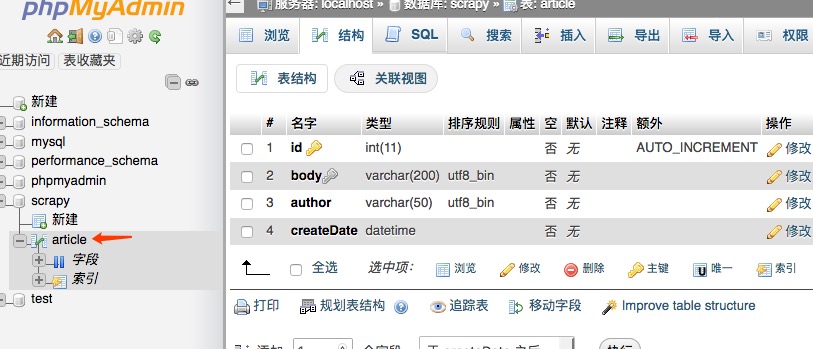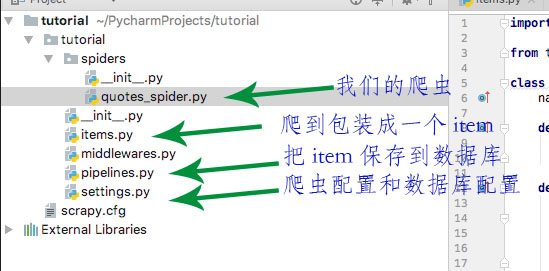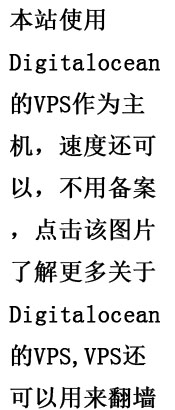Contents
1.环境建立
1.使用xmapp安装php, mysql ,phpmyadmin
2.安装python3,pip
3.安装pymysql
3.(windows 略)我这边是mac,安装brew,用brew 安装scrapy
2.整个流程
1. 创建数据库和数据库表,准备保存
2.写入爬虫目标URL,进行网络请求
3.对爬返回数据进行处理,得到具体数据
4.对于具体数据保存到数据库中
2.1.创建数据库
首先创建一个数据库叫scrapy,然后创建一个表article,我们这里给body加了唯一索引,防止重复插入数据
-- -- Database: `scrapy` -- -- -------------------------------------------------------- -- -- 表的结构 `article` -- CREATE TABLE `article` ( `id` int(11) NOT NULL, `body` varchar(200) CHARACTER SET utf8 COLLATE utf8_bin NOT NULL, `author` varchar(50) CHARACTER SET utf8 COLLATE utf8_bin NOT NULL, `createDate` datetime NOT NULL ) ENGINE=InnoDB DEFAULT CHARSET=latin1; -- -- Indexes for table `article` -- ALTER TABLE `article` ADD PRIMARY KEY (`id`), ADD UNIQUE KEY `uk_body` (`body`);
弄好以后是这样的。
2.2 先看下整个爬虫项目的结构
quotes_spider.py是核心,负责对网络请求和对内容进行处理,然后对整理好的内容抛给pipelines进行具体处理,保存到数据库中,这样不会影响速度。
其他的看 图说明
2.2 写入爬虫目标URL,进行网络请求
import scrapy
from tutorial.items import TutorialItem
class QuotesSpider(scrapy.Spider):
name = "quotes"
def start_requests(self):
url = 'http://quotes.toscrape.com/tag/humor/'
yield scrapy.Request(url)
def parse(self, response):
item = TutorialItem()
for quote in response.css('div.quote'):
item['body'] = quote.css('span.text::text').extract_first()
item['author'] = quote.css('small.author::text').extract_first()
yield item
next_page = response.css('li.next a::attr("href")').extract_first()
if next_page is not None:
yield response.follow(next_page, self.parse)start_requests 就是要写入具体要爬的URL
parse就是核心的对返回的数据进行处理的地方,然后以item的形式抛出,接下来定义好下一个要爬的内容
2.3 items
# -*- coding: utf-8 -*-
# Define here the models for your scraped items
#
# See documentation in:
# https://doc.scrapy.org/en/latest/topics/items.html
import scrapy
class TutorialItem(scrapy.Item):
body = scrapy.Field()
author = scrapy.Field()
pass
2.4 pipelines
# -*- coding: utf-8 -*-
# Define your item pipelines here
#
# Don't forget to add your pipeline to the ITEM_PIPELINES setting
# See: https://doc.scrapy.org/en/latest/topics/item-pipeline.html
import pymysql
import datetime
from tutorial import settings
import logging
class TutorialPipeline(object):
def __init__(self):
self.connect = pymysql.connect(
host = settings.MYSQL_HOST,
db = settings.MYSQL_DBNAME,
user = settings.MYSQL_USER,
passwd = settings.MYSQL_PASSWD,
charset = 'utf8',
use_unicode = True
)
self.cursor = self.connect.cursor();
def process_item(self, item, spider):
try:
self.cursor.execute(
"insert into article (body, author, createDate) value(%s, %s, %s) on duplicate key update author=(author)",
(item['body'],
item['author'],
datetime.datetime.now()
))
self.connect.commit()
except Exception as error:
logging.log(error)
return item
def close_spider(self, spider):
self.connect.close();2.5 配置
ITEM_PIPELINES = {
'tutorial.pipelines.TutorialPipeline':300
}
MYSQL_HOST = 'localhost'
MYSQL_DBNAME = 'scrapy'
MYSQL_USER = 'root'
MYSQL_PASSWD = '123456'
MYSQL_PORT = 33063.启动爬虫
scrapy crawl quotes1989




